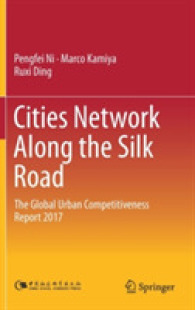- ホーム
- > 洋書
- > 英文書
- > History / World
Full Description
It is the quintessential nature of humans to communicate with each other. Good communications, bad communications, miscommunications, or no communications at all have driven everything from world events to the most mundane of interactions. At the broadest level, communication entails many registers and modes: verbal, iconographic, symbolic, oral, written, and performed. Relationships and identities - real and fictive - arise from communication, but how and why were they effected and how should they be understood? The chapters in this volume address some of the registers and modes of communication in the ancient Near East. Particular focuses are imperial and court communications between rulers and ruled, communications intended for a given community, and those between families and individuals. Topics cover a broad chronological period (3rd millennium BC to 1st millennium AD), and geographic range (Egypt to Israel and Mesopotamia) encapsulating the extraordinarily diverse plurality of human experience. This volume is deliberately interdisciplinary and cross-cultural, and its broad scope provides wide insights and a holistic understanding of communication applicable today. It is intended for both the scholar and readers with interests in ancient Near Eastern history and Biblical studies, communications (especially communications theory), and sociolinguistics.
Contents
Figures
Tables
Contributors
Abbreviations
General Introduction
Gillan Davis and Kyle H. Keimer, Communicating in the Past; Connecting with the Past
Part I. Imperial and Court Communications
Introduction to Part I
Chapter 1
Noel Weeks, The Disappearance of Cuneiform from the West and Elites in the Ancient Near East
Chapter 2
Samuel Jackson, Contrasting Representations and the Egypto-Hittite Treaty
Chapter 3
Luis R. Siddall, Text and Context: The Question of Audience for Sennacherib's 'Public' Inscriptions
Chapter 4
Wayne Horowitz, Communication and Miscommunication in the Southern Sky: The Case of Scorpio and the Southern Cross in Cuneiform
Chapter 5
Samuel N. C. Lieu, Imperialism and Language: Observations on Bilingual Inscriptions from Palmyra
Part II. Community Communications
Introduction to Part II
Chapter 6
Gareth Wearne, 'Guard it on Your Tongue!': The Second Rubric in the Deir ʿAlla Plaster Texts as an Instruction for the Oral Performance of the Narrative
Chapter 7
Rachelle Gilmour, Juxtaposition and Narrative Evaluation in Joshua 1-2
Chapter 8
Ian Young, Literature as Flexible Communication: Variety in Hebrew Biblical Texts
Chapter 9
Rachel Mansfield, Benjamin Overcash and Stephen Llewelyn, The Use of Paleo-Hebraic Script on Jewish Revolt Coins: A Semiotic Focus
Part III. Communications Between Families and Individuals
Introduction to Part III
Chapter 10
Peter Zilberg, From Dragomans to Babel: The Role of Interpreters in the Ancient Near East in the 1st Millennium B.C.E.
Chapter 11
Louise M. Pryke, Sex, Lies and Beautiful Eyes: Divine Communication and Premarital Relations in Sumerian Poetry
Chapter 12
Alanna Nobbs, Communication within a Dysfunctional Family in Late Antique Egypt








